What does it mean to be an Indigenous Christian in Australia today? It’s a question that invokes the difficult and contested history of colonisation and racial tension in this country. How did most Aboriginal and Torres Strait Islander families come by their Christian faith? Via missionaries and mission stations, to where thousands of Indigenous people were forcibly relocated, away from their traditional lands and the songs and stories that linked them to those lands. And yet, more than half of the Indigenous population today identifies as Christian. Elders of the community, while they express sorrow for the stolen children, land and wages, also recall happy memories from their mission station days. They express gratitude for the missionaries who taught them to read the Bible and worship the crucified and risen Jesus.
It’s July, a significant month for Australia’s Indigenous people. It was in July 1871 that Reverend Samuel MacFarlane, sponsored by the London Missionary Society, arrived in the Torres Strait Islands, triggering a religious and cultural transformation that is still celebrated today—the Coming of Light festival. July also plays host to NAIDOC, a nationwide celebration of Australia’s Indigenous cultures. The annual event dates back to 1938, when Aboriginal church networks, led by Indigenous activist William Cooper, promoted a National Day of Mourning to “call the attention to the present deplorable condition of all aborigines, of whatever stage of culture, after 150 years of British rule.”
This history highlights the complex relationship Australia’s Indigenous people have had with Christianity; church groups have both participated in Aboriginal dispossession and supported Aboriginal campaigns for recognition, equality and justice. This bittersweet ambivalence can be seen in various literary and artistic works even today. Let’s consider a few examples . . .

Gurrumul (film, 2018)
The death of Arnhem Land singer-songwriter Gurrumul Yunupingu last year sparked a national outpouring of sorrow and recognition that has continued this year with a documentary film released about his life and music. But while Yunupingu was lauded around the world when he released his debut album in 2008 (it garnered four ARIA nominations), his Gospel Album of 2015 attracted much less attention. It seems the left-leaning arts media was less comfortable with an Indigenous person expressing his Christian faith and roots, preferring instead a narrative focusing on the restoration and recognition of traditional indigenous spiritual beliefs.

Sweet country (film 2018)
This Western-inspired period drama is based on the true story of an Aboriginal man, Mr Kelly (newcomer Hamilton Morris), who shot a white man in self-defence in the Northern Territory in 1929. Kiwi actor Sam Neill’s Bible-reading preacher without a church is one of the few white characters with sympathy for Aboriginal people. “We’re all equal in the eyes of the Lord,” he says by way of explanation. This depiction hints at the earlier historical reality that, while church groups willingly participated in the “missionisation” of Australia’s Indigenous peoples, their motivation was usually compassion—yes, culturally ignorant and paternalistic in many ways, but a much better option than the alternative: outright massacre. And missionaries were often the first people to speak out against the injustices faced by Aboriginal people.

The Song Keepers (film, 2018)
The legacy of German Lutheran missionaries comes home to roost in this documentary film that follows the journey of the Central Australian Aboriginal Women’s Choir as they travel to Germany, the source of many of the songs they were taught during the mission days. Alternately comical and touching, The Song Keepers demonstrates how Christian practices have been thoroughly integrated into Central Desert cultures. “Like the choir’s musical performances, the film is imbued with a communal sense of joy,” says The Guardian’s enthusiastic review.

Our mob, God’s story (book, 2017)
Winner of the Australian Christian Book of the Year, this richly illustrated coffee table book contains a series of visual artworks by Aboriginal artists, each depicting a biblical story or expressing Christian faith in some way. The works are varied in their mediums and style, with traditional dot or X-ray paintings on one page and contemporary abstract works on the next. The artworks and the biographies of the artists themselves illustrate the diversity of Aboriginal Australia—coastal and desert nations are represented; artists from remote, regional and city communities all play their part.
The book suggests that it is indeed possible for a person to fully identify with both their Indigenous and Christian identities—the acceptance of one does not necessarily imply the rejection of the other. Yes, dilemmas remain—the traditional Aboriginal focus on the spirits of ancestors and the land, which is inconsistent with biblical teaching, for example—but solutions are possible.
Prisoner in Paradise (biography, 2017)
Sally Dudley’s self-published book could have done with some better editing—its scope is far too broad and the history is perhaps a little too comprehensive in its detail—but the reader is unavoidably confronted by the impact of past government policies and cultural attitudes by focusing on the life of Cedric (no surname given) who was in his late 60s and living in Mareeba, far north Queensland, when the book was published. He spent much of his childhood at the infamous Palm Island Aboriginal reserve after being removed from his unmarried mother. The reader is struck by the seemingly never-ending series of injustices and prejudices faced by Cedric and generations of his family, the cumulative impact of which is hard to grasp.
Writing from a Christian perspective, Dudley is perhaps a little too generous towards the Christian workers and institutions that played a part in Cedric’s family history—they are inevitably painted as “the good guys” and somehow separate from the policies they helped implement.
Prisoner in Paradise is quite focused on Queensland’s north, which will add extra interest for local readers.
Our story; God’s stories (short stories, 2017)
This slim volume contains a series of Christians’ “testimonies;” that is, personal memoirs of how God has led individuals towards conversion or a better understanding of who He is. In the process, however, the reader gets glimpses into Aboriginal history and culture, as each of the 18 storytellers recounts their unique experiences. There’s diversity, but the book is weighted towards outback communities in Western Australia, South Australia and the Northern Territory.

Mission songs project (CD/live show, 2017—ongoing)
A cultural research and preservation project as much as it’s a musical production, vocalist and entrepreneur Jessie Lloyd coordinated the recording of songs remembered from the mission days in locations along Australia’s east coast, from Tasmania to the Torres Strait Islands—“the secular songs that were sung after church . . . these rare songs consist of almost forgotten stories that can now shed light into the history of our Indigenous elders, families and communities,” says the project website. The flagship product is the 2017 album The Songs Back Home, but Lloyd has extended the life of the project, touring the songs nationally and internationally at the head of a female quartet, accompanied by ukulele and other traditional folk instruments.
“The Mission Songs Project works with songs that are for public use and the main aim is to ensure that these songs keep getting sung so they can be shared and taught,” Lloyd told NITV.
“The bigger picture is that these songs need to become Australian classics, just like ‘Waltzing Matilda.’ ”







